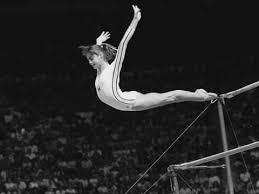In the history of sports, there are moments so extraordinary that they transcend the game itself moments that redefine what is possible. For gymnastics, that moment came on July 18, 1976, when a 14-year-old Romanian girl named Nadia Comăneci delivered a routine so flawless that the world had no way to measure it literally. The scoreboard read “1.00” because it wasn’t designed to display a perfect 10.
But Nadia had done it. She became the first gymnast in Olympic history to score a perfect 10.0, and in doing so, she forever changed gymnastics, becoming a global icon of excellence, discipline, and quiet revolution.
A Star is Born
Born in 1961 in Gheorgheni, Romania, Nadia began gymnastics at age six under the guidance of the now-legendary coaches Béla and Márta Károlyi. Her natural strength, agility, and focus quickly set her apart. She was selected for the Romanian national team by age nine, and by the time she was 13, she was already making waves on the international stage.
At the 1975 European Championships, Comăneci won four gold medals and a silver an early sign of her dominance. But it was at the 1976 Montreal Olympics where she captivated the world.
Montreal 1976: The Girl Who Broke the Scoreboard
Nadia’s performance on the uneven bars was nothing short of revolutionary. Her routine was crisp, daring, and performed with such fluid precision that the judges had no choice but to award a score never before given: 10.0. But the scoreboard wasn’t programmed for perfection it could only display up to 9.99 so the world saw “1.00” and held its breath.
She would go on to earn seven perfect 10s during the Games, ultimately winning three gold medals, a silver, and a bronze. At just 14, she became not just a champion, but a symbol of human potential.
Changing the Sport from the Ground Up
Nadia’s impact was immediate and lasting. Before her, gymnastics routines emphasized elegance and rhythm but Nadia introduced a new standard of athleticism, risk, and technical complexity. Her body control, timing, and calm under pressure became the new benchmarks for success.
Her performances also revolutionized how gymnastics was judged. After 1976, the sport saw a surge in global interest, especially among young girls. Gyms around the world filled with aspiring gymnasts inspired by the girl who made the impossible seem effortless.
Even the scoring system would eventually evolve first embracing more transparency, and later moving beyond the “10” system altogether. Yet, to this day, “a perfect ten” remains synonymous with Nadia Comăneci.
Resilience Beyond the Mat
Nadia’s post-Olympic life was as complex and compelling as her routines. After years of competing under Romania’s rigid Communist regime, she defected to the United States in 1989, seeking freedom and a new life. Her journey was marked by courage, much like her gymnastics.
She has since become a U.S. citizen, married fellow Olympic gymnast Bart Conner, and built a career as a coach, philanthropist, and global ambassador for sports and youth development. She continues to be an advocate for Olympic values, education, and fitness around the world.
An Enduring Legacy
Nadia Comăneci didn’t just earn medals she transformed gymnastics into an art form defined by both precision and poetry. Her influence is seen every time a young gymnast steps onto the floor with dreams of greatness. She taught the world that perfection, while rare, is real and that when it arrives, it leaves a mark forever.
More than four decades later, Nadia remains the gold standard in gymnastics a living legend whose name is not just remembered, but revered.

